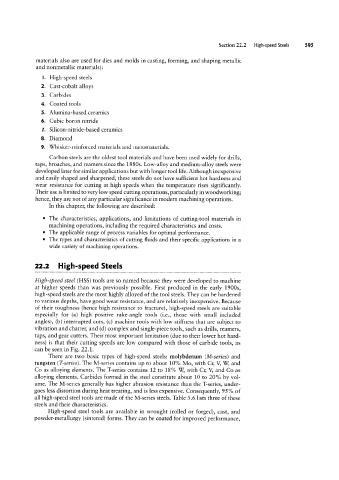Page 614 - 04. Subyek Engineering Materials - Manufacturing, Engineering and Technology SI 6th Edition - Serope Kalpakjian, Stephen Schmid (2009)
P. 614
Section 22 2 H|gh speed Steels
materials also are used for dies and molds in casting, forming, and shaping metallic
and nonmetallic materials):
I. High-speed steels
2. Cast-cobalt alloys
3. Carbides
4. Coated tools
5. Alumina-based ceramics
6. Cubic boron nitride
7. Silicon-nitride-based ceramics
8. Diamond
9. Whisker-reinforced materials and nanomaterials.
Carbon steels are the oldest tool materials and have been used widely for drills,
taps, broaches, and reamers since the 1880s. Low-alloy and medium-alloy steels were
developed later for similar applications but with longer tool life. Although inexpensive
and easily shaped and sharpened, these steels do not have sufficient hot hardness and
wear resistance for cutting at high speeds when the temperature rises significantly.
Their use is limited to very low speed cutting operations, particularly in woodworking;
hence, they are not of any particular significance in modern machining operations.
In this chapter, the following are described:
° The characteristics, applications, and limitations of cutting-tool materials in
machining operations, including the required characteristics and costs.
° The applicable range of process variables for optimal performance.
° The types and characteristics of cutting fluids and their specific applications in a
wide variety of machining operations.
22.2 High-speed Steels
High-speed steel (HSS) tools are so named because they were developed to machine
at higher speeds than was previously possible. First produced in the early 1900s,
high-speed steels are the most highly alloyed of the tool steels. They can be hardened
to various depths, have good wear resistance, and are relatively inexpensive. Because
of their toughness (hence high resistance to fracture), high-speed steels are suitable
especially for (a) high positive rake-angle tools (i.e., those with small included
angles), (b) interrupted cuts, (c) machine tools with low stiffness that are subject to
vibration and chatter, and (d) complex and single-piece tools, such as drills, reamers,
taps, and gear cutters. Their most important limitation (due to their lower hot hard-
ness) is that their cutting speeds are low compared with those of carbide tools, as
can be seen in Fig. 22.1.
There are two basic types of high-speed steels: molybdenum (M-series) and
tungsten (T-series). The M-series contains up to about 10% Mo, with Cr, \L WL and
Co as alloying elements. The T-series contains 12 to 18% W with Cr, \L and Co as
alloying elements. Carbides formed in the steel constitute about 10 to 20% by vol-
ume. The M-series generally has higher abrasion resistance than the T-series, under-
goes less distortion during heat treating, and is less expensive. Consequently, 95% of
all high-speed steel tools are made of the M-series steels. Table 5.6 lists three of these
steels and their characteristics.
High-speed steel tools are available in wrought (rolled or forged), cast, and
powder-metallurgy (sintered) forms. They can be coated for improved performance,

